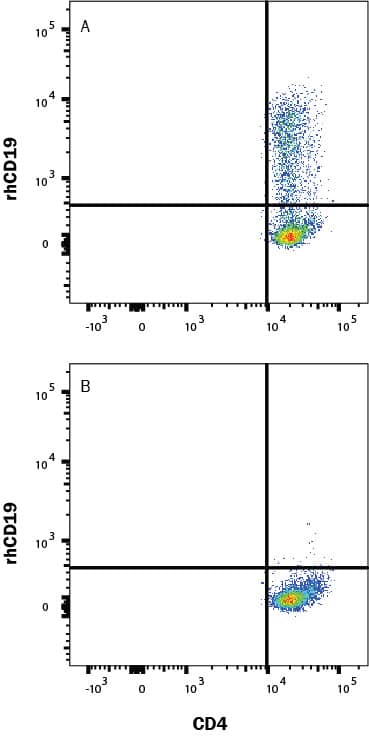Recombinant Human CD19 Protein, Atto 488 Conjugate
R&D Systems, part of Bio-Techne | Catalog # ATJ9269
Fc Chimera

Key Product Details
Learn more about FluorokinesTM Fluorescent-Labeled Proteins
Source
CHO
Accession #
Structure / Form
Disulfide-linked homodimer, labeled with Atto 488 via amines
Excitation Wavelength: 501 nm
Emission Wavelength: 523 nm
Excitation Wavelength: 501 nm
Emission Wavelength: 523 nm
Conjugate
ATTO 488 (Excitation= 501 nm, Emission= 523 nm)
Applications
Bioactivity
Product Specifications
Source
Chinese Hamster Ovary cell line, CHO-derived human CD19 protein
| Human CD19 (Glu21-Lys291) Accession # P15391 |
IEGRMD | Human IgG1 (Pro100-Lys330) |
| N-terminus | C-terminus |
Purity
>90%, by SDS-PAGE visualized with Silver Staining and quantitative densitometry by Coomassie® Blue Staining.
Endotoxin Level
<1.0 EU per 1 μg of the protein by the LAL method.
N-terminal Sequence Analysis
Glu21
Predicted Molecular Mass
57 kDa
SDS-PAGE
77-92 kDa, under reducing conditions
Activity
Measured by flow cytometry for its ability to bind
anti-Human CD19 Monoclonal Antibody conjugated fluorescent beads.
Scientific Data Images for Recombinant Human CD19 Protein, Atto 488 Conjugate
Detection of CD19 construct on human CART cells
Human PBMC CD4+ and CD8+ T cells were either (A) transduced or (B) not transduced (negative control) with a Human CD19 CAR and then cultured for 11 days. Cells were washed twice with 2mL 1x PBS then stained with a viability dye for 15-30 min at room temp in the dark. Human block (1-001-A) was added during the viability stain to block Fc receptors. Cells were washed twice with Flow Cytometry Staining Buffer (FC001) then stained with Human CD4 PE-Cy7-conjugated Antibody and rhCD19 Atto 488-conjugated protein (ATJ9269) for 25 min at room temp in the dark. Staining was performed using our staining membrane proteins protocol.Recombinant Human CD19 Protein, Atto 488 Conjugate SDS-PAGE.
2 μg/lane of Recombinant Human CD19 Fc Chimera Atto 488 (ATJ9269) was resolved with SDS-PAGE under reducing (R) and non-reducing (NR) conditions and visualized by Coomassie® Blue staining, showing bands at 77-92 kD and 154-184 kDa, respectively.Formulation, Preparation and Storage
ATJ9269
| Formulation | Supplied as a 0.2 μm filtered solution in PBS with BSA as a carrier protein. |
| Shipping | The product is shipped with dry ice or equivalent. Upon receipt, store it immediately at the temperature recommended below. |
| Stability & Storage | Protect from light. Use a manual defrost freezer and avoid repeated freeze-thaw cycles.
|
Background: CD19
References
- Wang, K. et al. (2012) Exp. Hematol. Oncol. 1:36.
- Tedder, T.F. et al. (1997) Immunity 6:107.
- Tedder, T.F. and C.M. Isaacs (1989) J. Immunol. 143:712.
- Rickert, R.C. et al. (1995) Nature 376:352.
- Engel, P. et al. (1995) Immunity 3:39.
- Vences-Catalan, F. et al. (2012) J. Immunol. 137:48.
- Deaglio, S. et al. (2007) Blood 109:5390.
- Bradbury, L. et al. (1992) J. Immunol. 149:2841.
- Krop, I. et al. (1996) J. Immunol. 157:48.
- O'Rourke, L.M. et al. (1998) Immunity 8:635.
- Buhl, A.M. et al. (1997) J. Exp. Med. 186:1897.
- Sato, S. et al. (1995) Proc. Natl. Acad. Sci. USA 92:11558.
- Carter, R.H. and D.T. Fearon (1992) Science 256:105.
Alternate Names
CD19, CVID3, Leu-12
Entrez Gene IDs
Gene Symbol
CD19
UniProt
Additional CD19 Products
Product Documents for Recombinant Human CD19 Protein, Atto 488 Conjugate
Product Specific Notices for Recombinant Human CD19 Protein, Atto 488 Conjugate
For research use only
